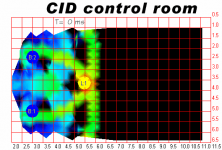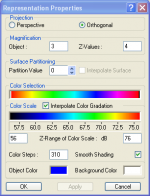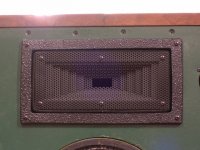Yes, absolutely! I'll try that if I can, but the sims take a long time to run. In a box room with 4 walls, the sims take but a few seconds. Once things get complex with all sorts of angles and soffits and such, the sims can take a couple of hours or more. So I don't do them at the drop of a hat.It would be interesting to see how directivity patterns influence the results.
That only works if the code is written for parallel processing. Otherwise it just runs on one core no matter how many you have. Not much software is written to use multiple cores. If its older, unless it was completely rewritten it is most likely not parallel code.
True, it also seems that lots of software are multi-thread/multi-core. It's easy to check I think.
The CARA calculations run on both processors, but only at 50% on each. Maybe I can change that with some settings. But at least that way I can surf the net while the software crunches the numbers.
I don't think that you can tell if the code is written as multitasking. Thats because some things like OS or .Net calls can be mutitasked by the OS. But if say an FFT algorithm is not written to multi-task then the OS cannot just do that.
If the processors are running at 50% equally during pretty much the entire calculation then yes the most significant calcs would have to be written parallel.
The coolest thing that I have seen lately are the compilers that will parallel operations and route them to the GPU, which is massively parallel. But again, the code has to be compiled with custom compilers. I have read about ten fold speed improvments on massive array computations.
If the processors are running at 50% equally during pretty much the entire calculation then yes the most significant calcs would have to be written parallel.
The coolest thing that I have seen lately are the compilers that will parallel operations and route them to the GPU, which is massively parallel. But again, the code has to be compiled with custom compilers. I have read about ten fold speed improvments on massive array computations.
The coolest thing that I have seen lately are the compilers that will parallel operations and route them to the GPU, which is massively parallel. But again, the code has to be compiled with custom compilers. I have read about ten fold speed improvments on massive array computations.
Yeah, GPU processing is pretty intense, I'm surprised there aren't more A/V apps written to take advantage of it yet.
The image servers I use are. The CPU load is pretty low, just video decoding. The heavy lifting is done on the GPU.I'm surprised there aren't more A/V apps written to take advantage of it yet.
BBC CID simulation
OK, finally got enough time at home to put this together.
In CARA room simulation software I drew the CID control room as found in the BBC paper Speaker Dave found. http://downloads.bbc.co.uk/rd/pubs/reports/1995-04.pdf
I drew control room B12, as seen in figure 12. It put in very little acoustic treatment, just Berber carpet and the absorption on the inside of the arches. All front walls and the ceiling are hard. The rear wall is heavily padded for no back slap.
Click here to see animation of CID Room
Also below you will see the same room with mucho sound deadening. Front wall, first 1/3 of the side walls, ceiling. Acoustic tile on the ceiling, too.
Click here to see animation of Dead Room
The animations show a Direc pulse from its origin out to >20ms after arrival at the listener. Red=76dB, Black=56dB or lower. The paper sets -20dB as the goal for reflections, so if you see black, it's been reached. You'll notice that both the highly treated "Dead Room" and the CID room do well in achieving -20dB reflections thru the first 20ms. They do it in very different ways, though.
OK, finally got enough time at home to put this together.
In CARA room simulation software I drew the CID control room as found in the BBC paper Speaker Dave found. http://downloads.bbc.co.uk/rd/pubs/reports/1995-04.pdf
I drew control room B12, as seen in figure 12. It put in very little acoustic treatment, just Berber carpet and the absorption on the inside of the arches. All front walls and the ceiling are hard. The rear wall is heavily padded for no back slap.
Click here to see animation of CID Room
Also below you will see the same room with mucho sound deadening. Front wall, first 1/3 of the side walls, ceiling. Acoustic tile on the ceiling, too.
Click here to see animation of Dead Room
The animations show a Direc pulse from its origin out to >20ms after arrival at the listener. Red=76dB, Black=56dB or lower. The paper sets -20dB as the goal for reflections, so if you see black, it's been reached. You'll notice that both the highly treated "Dead Room" and the CID room do well in achieving -20dB reflections thru the first 20ms. They do it in very different ways, though.
Attachments
The Mac and iOS GUI's both use OpenGL for everything displayed on the screen, (even text) all the layers, compositing, animated effects etc are OpenGL based and fully GPU accelerated, keeping the CPU load very low and the interface fluid, especially on the mobile devices.Apple GUI are so responsive that I wonder whether the to do stuff.
Well, Windows has a slow response; OpenGL is used in some CAD systems, but not for Windows GUI. Not sure what Unix/Linux systems use in general. I know we did use OpenGL for simulation models and image generation/management. Current Android systems seem to lag quite a bit as well.
Well, Windows has a slow response; OpenGL is used in some CAD systems, but not for Windows GUI.
As I said, OpenGL can be used for anything in windows, its an option for the developer - its part of .Net. OpenGL is open source as I recall so any OS can use it. Windows has had it for more than a decade.
As to Windows have "a slow response", its perception and your computer. Mine is certainly not slow.
Way off topic, but...As I said, OpenGL can be used for anything in windows, its an option for the developer - its part of .Net. OpenGL is open source as I recall so any OS can use it. Windows has had it for more than a decade.
You missed the point. Windows and Mac OS both make OpenGL available to applications to use for their own 3D drawing purposes within their own windows, but only the Mac OS uses OpenGL as the underlying technology to render the entire user interface. All buttons, widgets, scrollbars, windows, layers etc are composited and rendered using OpenGL calls. The entire desktop is one big OpenGL scene even if you are not using any "3D" applications. Thus all the built in GUI animations and compositing tricks are simply OpenGL calls.
Windows does not do this. Windows programs which do not themselves make direct use of OpenGL (or Direct3D) within their window render using GDI calls and the desktop as a whole is composited and rendered using a fairly simple 2D compositor with alpha blending and not much else.
Yes, way off topic, but it is my understand that this all changed after Vista with the complete makeover of the GUI and the implimentation of WPF. GDI calls are now considerd obsolete.
Win7 runs slower. I find myself constantly switching to the old GUI. Fail to understand the need for change other than looking flashy. Day to day use is only marginally improved considered the vast amount of resources used, what a waste.
It's like building an omni directional speaker and placing it near to a wall.
It's like building an omni directional speaker and placing it near to a wall.
Glad to see that my BBC control room simulations got so many comments (not). 😛
https://production.diyaudio.com/community/index.php?posts/3019353/
I guess computer OSes are a more interesting topic. No matter, it taught me a lot about rooms and is an approach that I hope to use sometime soon. I've been looking for good diffraction or diffusion techniques for the front wall, this just may be the ticket. Doing just the vertical section helps, but adding the horizontal soffits really seals the deal.
https://production.diyaudio.com/community/index.php?posts/3019353/
I guess computer OSes are a more interesting topic. No matter, it taught me a lot about rooms and is an approach that I hope to use sometime soon. I've been looking for good diffraction or diffusion techniques for the front wall, this just may be the ticket. Doing just the vertical section helps, but adding the horizontal soffits really seals the deal.
- Status
- Not open for further replies.
- Home
- Loudspeakers
- Multi-Way
- What is the ideal directivity pattern for stereo speakers?



